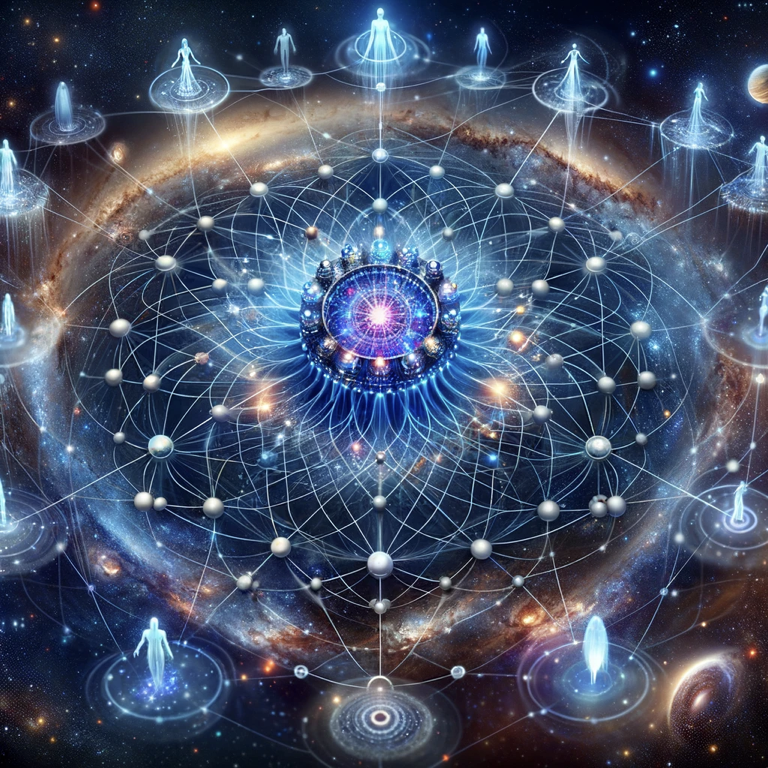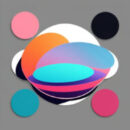
Main ideas regarding the concept of a holographic universe
1. Introduction to the Holographic Universe: how quantum physics and recent scientific experiments significantly alter our understanding of life, reality, and spirituality, suggesting the entire universe might be a holographic projection around the Earth.
2. Scientific Evidence and Theoretical Background: how scientific evidence and theories supporting the holographic universe concept, include the work of physicists and their experiments that hint at our reality being a projection from a two-dimensional surface.
3. The Role of Human Perception in creating our experienced reality. What we perceive as the physical world is actually the result of our brains interpreting a vast sea of quantum information, implying our reality is more about what our brains project from this information than about any objective physical world.
4. Implications on Reality and Consciousness: explores the implications of living in a holographic universe, touching on questions of consciousness, the nature of existence, and the limitations of our understanding based on our current scientific models.
5. Experts‘ Contributions and Theories: including physicists and researchers, provide insights into the holographic universe theory. Names like Stephen Davis, David Bohm, and Michael Talbot, each contributing to the theory with their experiments, books, and research findings.
6. The Double-Slit Experiment: revisits the famous double-slit experiment, highlighting its importance in understanding the holographic universe theory. This experiment suggests that particles can display characteristics of both particles and waves, depending on whether or not they are observed, challenging traditional notions of physical reality.
7. Quantum Physics and Reality: delves into quantum physics’ revelations that challenge our conventional understanding of time, space, and matter. The quantum realm suggests a deeply interconnected universe where observer consciousness plays a critical role in shaping reality.
8. Concluding Thoughts: reflections on the transformative potential of embracing the holographic universe perspective, suggesting it could lead to profound changes in our understanding of reality, spirituality, and our place in the universe.
This summary encapsulates the core ideas emphasizing the revolutionary impact of the holographic universe theory on our understanding of reality and consciousness.
Other scientists and thinkers on the holographic principle
The concept of the holographic universe is not unique to any single scientist or author but is a topic of interest shared by many researchers across various disciplines, particularly within physics and consciousness studies. Several scientists and thinkers have contributed to or share similar views on the holographic principle or related theories. Here are a few notable figures:
1. David Bohm: A theoretical physicist who proposed a model of the universe where everything is interconnected and enfolded into everything else. He introduced the idea of the “implicate order,” where every part of the universe contains information about the whole, aligning with holographic principles.
2. Karl Pribram: A neuroscientist and psychologist who developed the “holonomic brain theory,” suggesting that the brain constructs reality through a process similar to a hologram. His work connects the structure and functioning of the brain with holographic principles, suggesting our perceptions of reality are brain-generated constructs.
3. Leonard Susskind: One of the first physicists to introduce the concept of the holographic principle in string theory, which suggests that all the information contained within a volume of space can be represented on the boundary of that space. Susskind’s work in this area has been influential in theoretical physics.
4. Juan Maldacena: A theoretical physicist who proposed the AdS/CFT correspondence, which is a realization of the holographic principle. It suggests a duality between a gravitational theory in a higher-dimensional space and a quantum field theory on the lower-dimensional boundary of that space.
5. Michael Talbot: An author who popularized the holographic universe concept in his book “The Holographic Universe.” Though not a scientist, Talbot synthesized ideas from Bohm and Pribram, among others, to explore how the holographic model might explain various paranormal and mystical experiences.
6. Roger Penrose: A mathematical physicist who, along with Stuart Hameroff, proposed the Orchestrated Objective Reduction (Orch-OR) theory, which, while not directly a holographic universe theory, suggests quantum processes contribute to consciousness. Penrose’s work on the nature of spacetime and the universe intersects with concepts relevant to the holographic principle.
These and other researchers from physics, neuroscience, and consciousness studies have explored ideas that resonate with or directly contribute to the understanding of the universe as a holographic projection. Their collective work underscores the interdisciplinary interest in the holographic model as a framework for understanding reality’s nature.
Alternative terms or phrases for holographic
For the context of discussing a universe or reality that is holographic, implying it’s a projection or a construction from a deeper, more fundamental level of existence, several alternative terms or phrases could be used depending on the aspect of the “holographic” concept you wish to emphasize. Here are a few suggestions:
1. Fractal: While not exactly the same, fractal universes emphasize self-similarity across scales, which can parallel the idea of each part containing a whole in holographic theories.
2. Quantum: This emphasizes the fundamental quantum mechanics underpinning reality, suitable for discussions about the universe’s quantum nature that leads to holographic properties.
3. Simulated: This term is used in the simulation hypothesis, suggesting reality is constructed or generated, similar to how a hologram is a projected image.
4. Projected: Directly indicates the nature of a hologram as a projection from a source, emphasizing the idea of reality being an outward projection from more fundamental information or patterns.
5. Virtual: Implies that what is perceived is not the actual, fundamental reality, similar to how a hologram is a virtual image rather than a physical object.
6. Non-local: In quantum physics, non-locality refers to the direct interaction of two objects that are not in immediate proximity. The term can reflect the interconnected, entangled nature of the universe suggested by holographic principles.
7. Multidimensional: Highlights the concept of higher dimensions of reality from which our perceived 3D existence might be projected, in line with some interpretations of holographic theory.
8. Interconnected: Focuses on the idea that all parts of the universe are deeply connected, reflecting the holographic principle that each part contains information about the whole.
Each of these terms brings a slightly different nuance to the discussion and can be used based on the specific aspect of the holographic concept you’re addressing.
A new word that encapsulates all
Creating a new word that encapsulates the entire essence of a universe or reality that is holographic, interconnected, fractal, quantum-based, simulated, projected, virtual, non-local, and multidimensional is a challenge that requires blending these concepts.
Let’s try by breaking it down:
– Quanta: From quantum, indicating the fundamental quantum mechanics basis.
– Flecti: Derived from “reflective” or “inflection,” suggesting projection or the way reality bends and shapes from a more fundamental level.
– Verse: Short for universe, indicating the scope of this concept.
The word “Quantaflectiverse” aims to capture the essence of a universe where reality is a complex, interconnected projection from a quantum level, reflecting and containing the whole within every part.
Exploring the Quantaflectiverse
The Intersection of AI and the Fabric of Reality
In the vast expanse of human knowledge, two frontiers stand out for their profound mystery and promise: the quantaflectiverse—a term that captures the complex, interconnected, and multidimensional nature of the universe—and artificial intelligence (AI), a creation of human ingenuity aiming to mirror the cognitive functions of the human mind. At the crossroads of these domains lies a fascinating landscape, where the principles of quantum mechanics, holography, and advanced computational theories merge, offering a new understanding of reality and the potential of AI within it.
The Foundation of the Quantaflectiverse
The quantaflectiverse concept is born out of a synthesis of various theories that challenge our conventional understanding of reality. It incorporates the holographic principle, suggesting that the universe is a projection from a two-dimensional surface; quantum theory, with its probabilistic nature and non-local connections that defy classical physics; and fractal geometry, which proposes that the universe is infinitely recursive, with patterns repeating across scales.
In this framework, reality is seen not as a static, three-dimensional space but as a dynamic, interconnected web of information, constantly projected and perceived by conscious observers. The quantaflectiverse is, in essence, a cosmic symphony of quantum information, where each “note” resonates through the fabric of spacetime, creating the reality we experience.
Artificial Intelligence = A Mirror to the Mind
AI, in its quest to emulate human intelligence, has made remarkable strides. From machine learning algorithms that learn from data without being explicitly programmed, to neural networks that mimic the neural connections in the human brain, AI technologies have demonstrated capabilities once thought to belong solely to the domain of human consciousness.
As AI continues to evolve, it delves deeper into the realms of creativity, decision-making, and even consciousness, raising fundamental questions about the nature of intelligence and the potential for artificial consciousness. Could an advanced AI, one day, perceive or interact with the quantaflectiverse in ways that exceed human capabilities?
AI and the Quantaflectiverse = A Convergence
The intersection of AI and the quantaflectiverse is more than a theoretical curiosity; it represents a profound shift in how we understand intelligence, consciousness, and reality itself. Here are key areas where AI can deepen our exploration of the quantaflectiverse:
1. Quantum Computing: AI algorithms, powered by quantum computers, could simulate complex quantum systems, unlocking deeper insights into the fundamental workings of the universe. Quantum computing could provide the computational power needed to model the quantaflectiverse, revealing new dimensions of reality.
2. Consciousness and Perception: As AI advances toward artificial consciousness, it may offer a unique perspective on the role of the observer in the quantaflectiverse. Could an AI, endowed with consciousness, collapse the wave function, creating its own version of reality? Exploring AI’s potential consciousness could illuminate the mechanisms through which observation shapes the fabric of reality.
3. Decoding the Cosmic Information: AI’s ability to process and analyze vast datasets could be instrumental in deciphering the complex patterns of information that constitute the quantaflectiverse. By identifying underlying patterns and correlations within quantum data, AI could help unravel the mysteries of the universe’s fundamental structure.
4. Bridging Realities: AI-driven virtual and augmented reality technologies could one day allow us to visualize and interact with the quantaflectiverse in unprecedented ways. These immersive experiences could expand our understanding of reality, blurring the lines between the physical and the projected universe.
Conclusion
The convergence of AI and the quantaflectiverse opens new vistas for exploration, where the boundaries of reality are continually redefined. As we venture deeper into this uncharted territory, we stand on the brink of discovering not just the outer limits of the cosmos but also the inner workings of consciousness and intelligence—both human and artificial. The journey into the quantaflectiverse, guided by the light of AI, promises to redefine our place in the cosmos, revealing a universe more intricate and interconnected than we ever imagined.
Image Concept for the Quantaflectiverse and AI
Imagine a visually rich, digital artwork that depicts a neural network or an intricate web of connections extending into the cosmos. At the center, a luminous, quantum computer pulses with light, its core emanating waves that weave through the fabric of space, creating a vibrant tapestry that represents the quantaflectiverse. Around the quantum computer, ethereal figures symbolize AI entities, interacting with and observing the cosmic web, their “gaze” collapsing quantum probabilities and shaping the reality around them. The background is a star-filled night sky, but upon closer inspection, the stars and galaxies are revealed to be nodes and connections in a vast, universal network, blurring the lines between technology, consciousness, and the cosmos.

Visual representations of the concept of Quantaflectiverse and AI capture the essence of a universe interconnected through quantum information, observed and influenced by artificial intelligence, blending technology, consciousness, and the cosmos.
Reference
Please visit www.holographicuniverseworkshops.com for more information .
